Scale insects are plant parasites that attach themselves to host plants‘ leaves, branches, and stems. Like mealybugs, they are difficult to control because they secrete hard shells that conceal their body and make it difficult for the chemicals to penetrate their body.

A display of healthy houseplants free from outdoor pests
On infested plants, the presence of scale insect looks like raised bumps of dark brown or black color. They can kill your favorite fruit trees, shrubs, and houseplants. Therefore, the timely detection of these pests can prevent your plants from being damaged.
Scale insects are difficult to control with chemicals because their hard body coverings repel the insecticides. At the same time, they are difficult to detect through the naked eye due to their camouflage abilities. Therefore, the best way to treat these sap-sucking pests is through integrated pest management strategies.
This write-up will discuss all possible ways (least toxic to chemical control) to protect plants.
The best approach to control scale insects is integrated pest management (IPM). It involves the combination of cultural, biological, and chemical control.
What Are Scale Insects?
Scale insects are a large and diverse group of sap-sucking pests. Moreover, there are 8000 species of these pests in the family Coccoidea of the order Homoptera. They invade many host plants ranging from ornamental plants to shade trees and herbs.
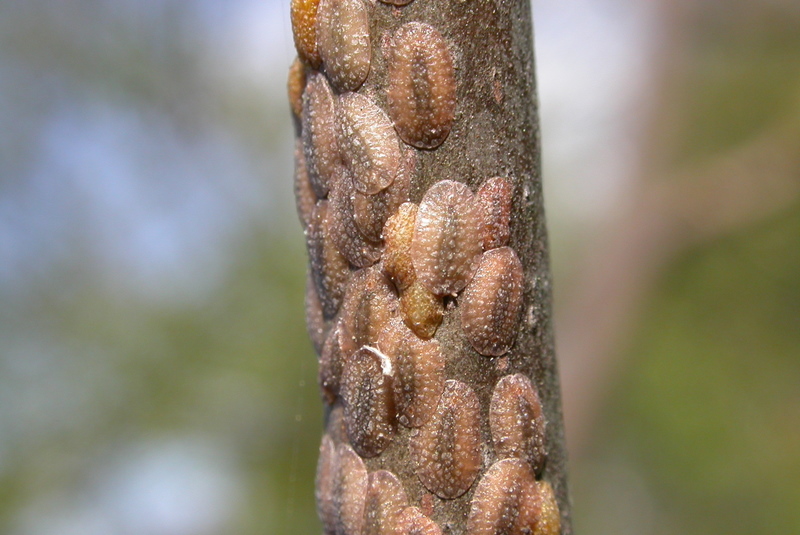
Scale insects attached to a stem—how intelligent they are (have camouflaged themselves)
Scale insects are closely related to whiteflies, aphids, and mealybugs and have many differences from other typical garden pests. For example, many scale insects can kill ornamental plants while others cause slow decline.
They are weirdly shaped and immobile problems that appear as raised scars or bumps on infested plants. These raised shells protect the insect body beneath. The scale insect coverings are oval to dome-shaped and oyster shell-shaped.
Note: Scale insects also resemble individual reptiles and fish scales on woody plants due to their waxy covering.
Damage Caused By Scale Insects
Scale insects feed on the nutrients of herbaceous plants, trees, and shrubs. They suck plant sap through piercing-sucking mouthparts. The constant feeding leads to yellowing of leaves and loss of plant strength against insect pests.
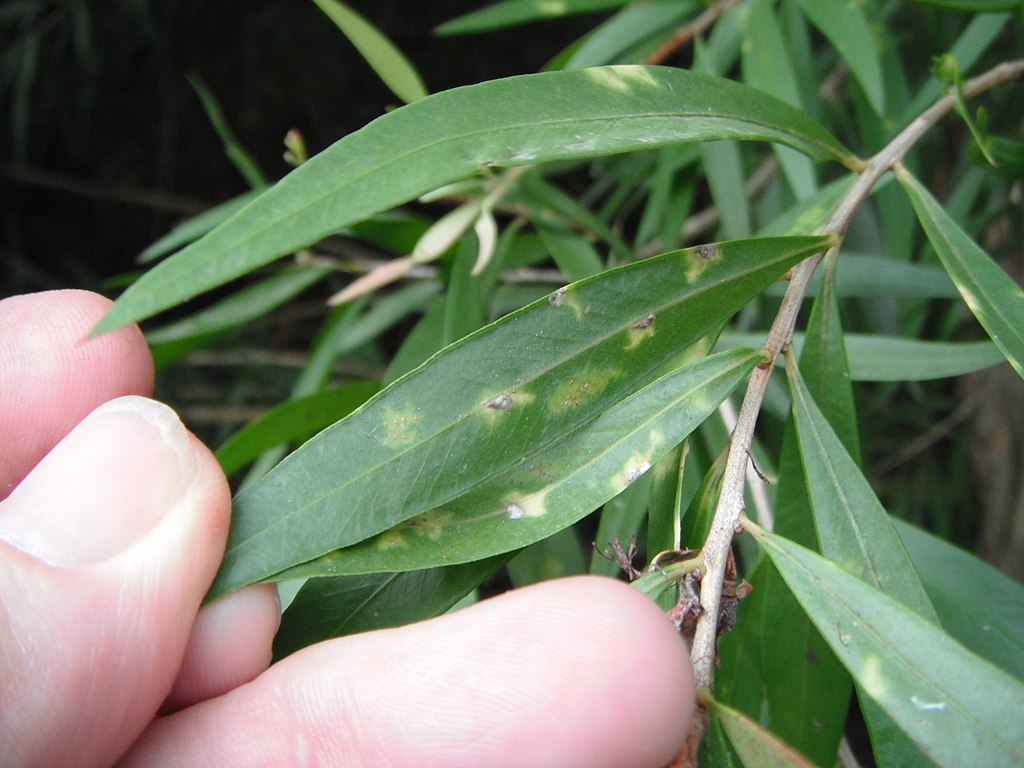
Scale insect damage on paperbark bottlebrush—the damage appears as light yellow spots on leaves
The weakened plants are more susceptible to drought, heat, and light injuries. Even these plants are more prone to other insects such as borers and fungal diseases.
While feeding on host plants, soft scales secrete a sticky, sugary substance—honeydew. Honeydew is a mixture of water and sugars that pass through the insect’s digestive tract and excrete on leaves and branches.
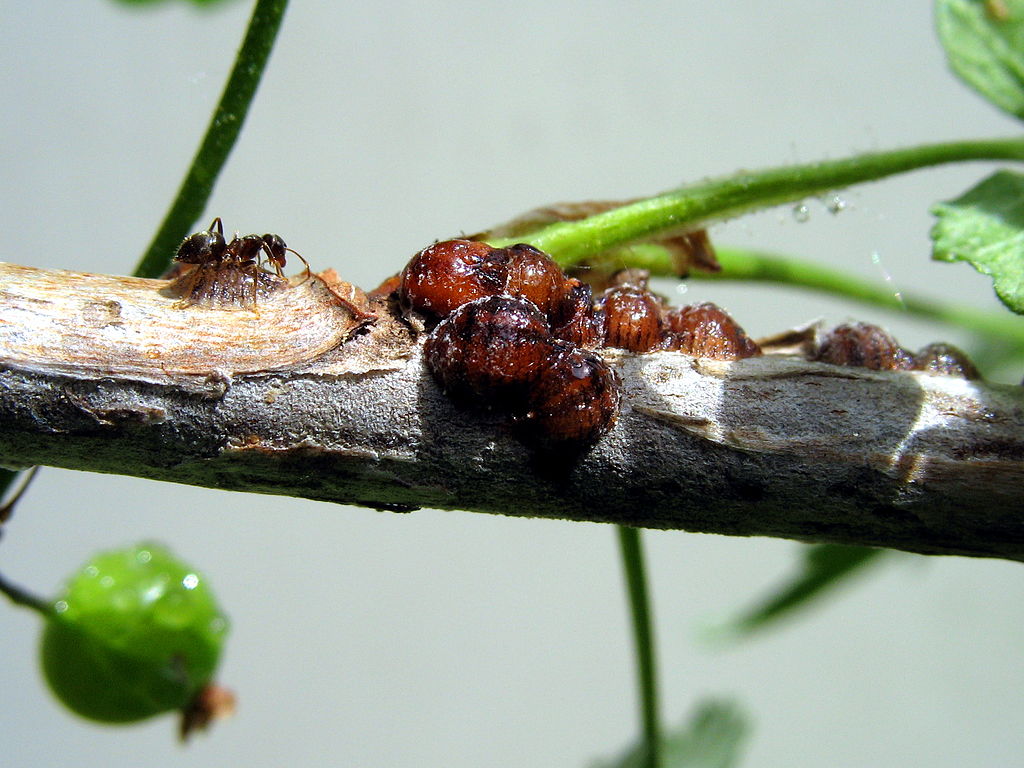
Black ants tend the brown soft scale against natural enemies because they feed on honeydew
The secretion of sugary material on leaves attracts the black ants and black sooty mold fungus. These secondary pests feed on honeydew and protect the soft scales from natural enemies.
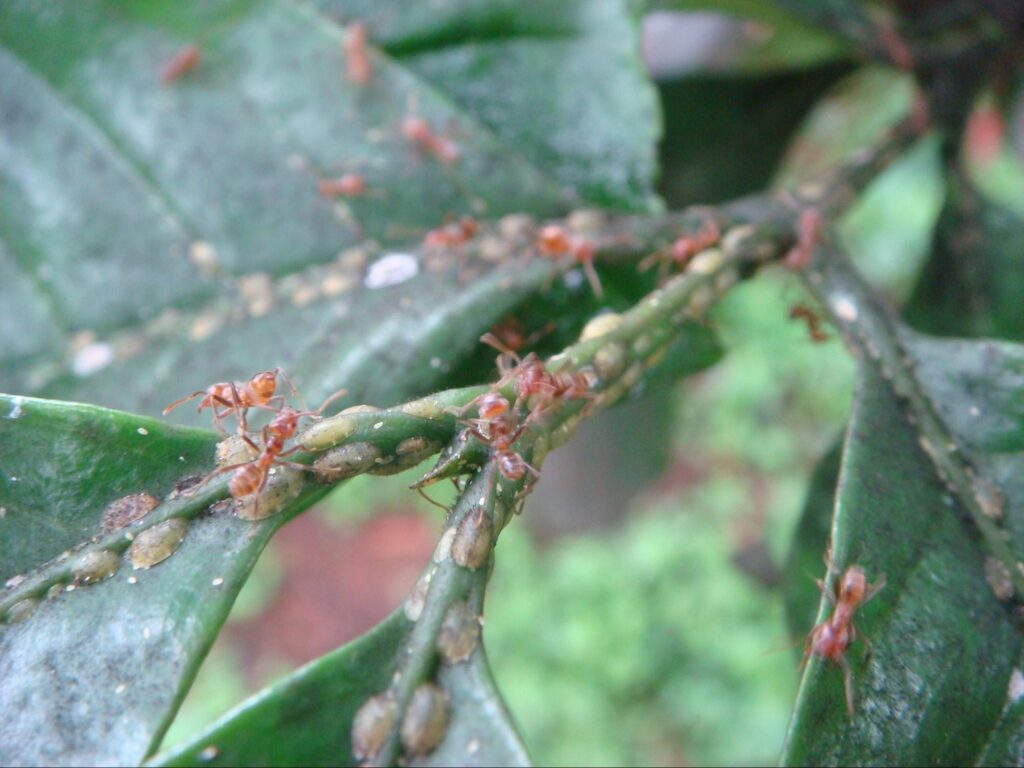
Predatory beetles and ants on the same host plant infested with soft scales
In the above image, the Azteca ants and predatory beetles chase the green coffee scale insect with a different purpose. Azteca ants guard the green coffee scale insects for sugary and sticky material—honeydew. On the other hand, the predatory beetles are for green coffee scales to feed on them.
To keep the predatory beetles away from scales, Azteca ants fight them off and interfere with their feeding process.
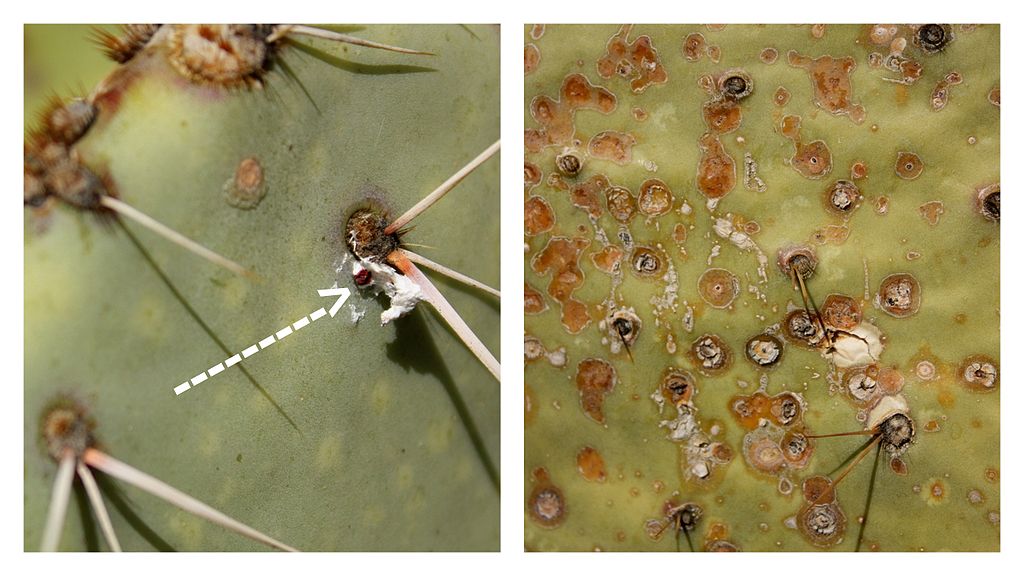
Damage caused by tiny scale insects on prickly pear
Life Cycle Of Scale Insects
The life cycle of scale insects is simple and consists of eggs, larvae (crawlers), and adults. Adult females lay eggs underneath the scale covering.
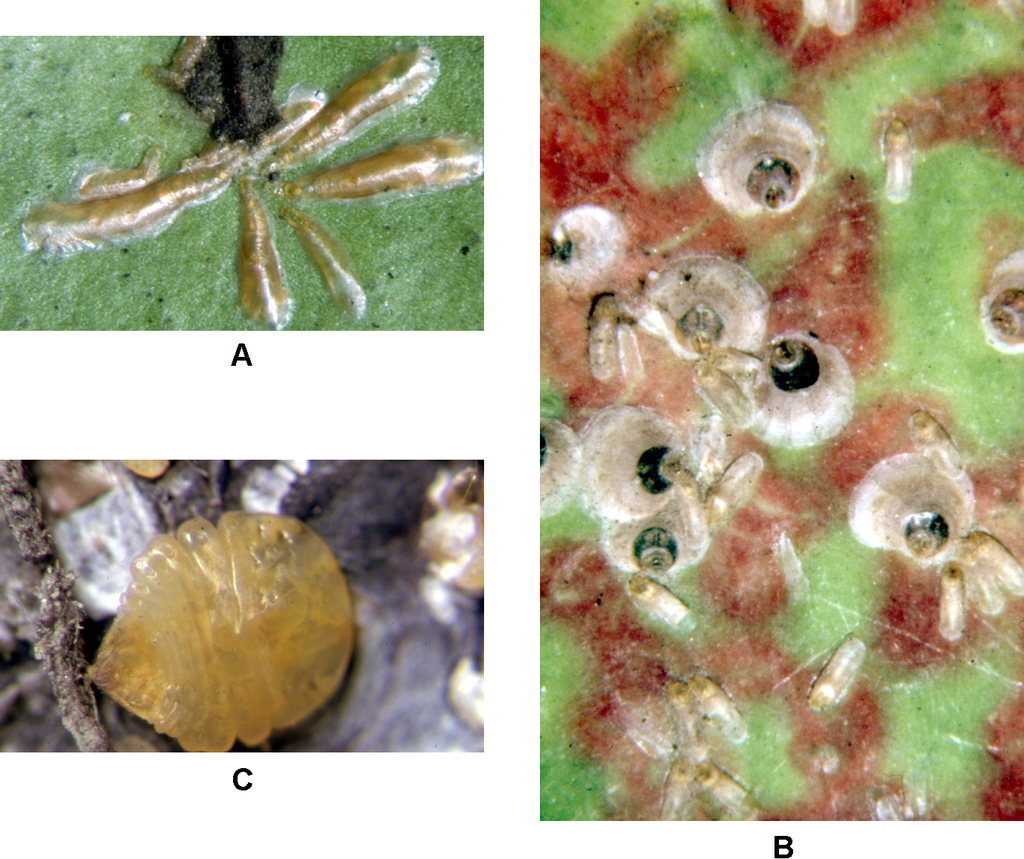
The complete life cycle of an armored scale
When the eggs hatch, tiny immature scales emerge. The crawlers have antennas and legs. They cover a smaller distance from their parental scale, searching for food, and settle in their feeding sites. This is the only crawler stage on the host plant for most scale species.
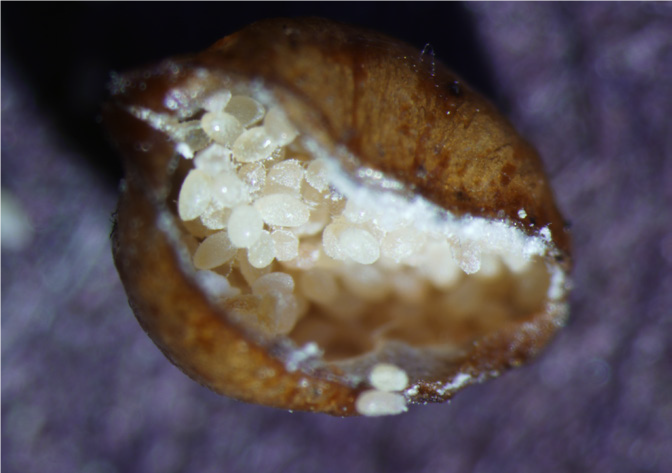
Tiny white eggs below the scale covering
Once the crawlers find suitable feeding sites, insert their piercing mouthparts into plant tissues and feed on plant sap. As they continue to feed on plant sap, they secrete a waxy covering that covers the body of crawlers.
The crawlers undergo several molts during the feeding phase and lose their legs and antennae. However, larvae and female scales remain at the same feeding site for the rest of their life. While the male scale is tiny, gnat-like insects and strong fliers.
The male adult scales fly in search of new female scales for mating. Scale insects have one or two generations per year. At the same time, some scale species, such as the euonymus scale, have many overlapping generations on the host plant.
The active period for scale insect development is late winter to early summer. At their peak growth time, they damage many trees and shrubs.
Identification Of Scale Insects
The adult scales are 1/16 to 3/8 inch long and give the appearance of a tiny fish scale. They even change their body color to host plant appearance. The name “scale insects” is derived from the characteristic hard covering they secrete around their bodies.
Furthermore, scale insects are divided into two categories based on armored and soft scales based on waxy coverings.
Soft Scales
Soft scales produce a thin, soft covering almost 1/2 inch long around their body that cannot be separated. They can move over a small distance in their life because female scales do not lose their legs and antenna during molting. However, the female soft scales reduce their size to maintain mobility.

Soft scales attached to host plant stem
These tiny soft scales overwinter as immature or fertilized females. They mostly themselves on the underside of leaves and stems. At the same time, some species attach themselves to the upper surfaces of leaves.
The damage of soft scales to host plants include browning, yellowing, and distortion of leaves. In addition, defoliation and wilting occur in heavy infestations of plants by soft scales. Soft scales also produce honeydew in significant amounts that attract more ants and sooty mold fungus and interfere with natural predators.
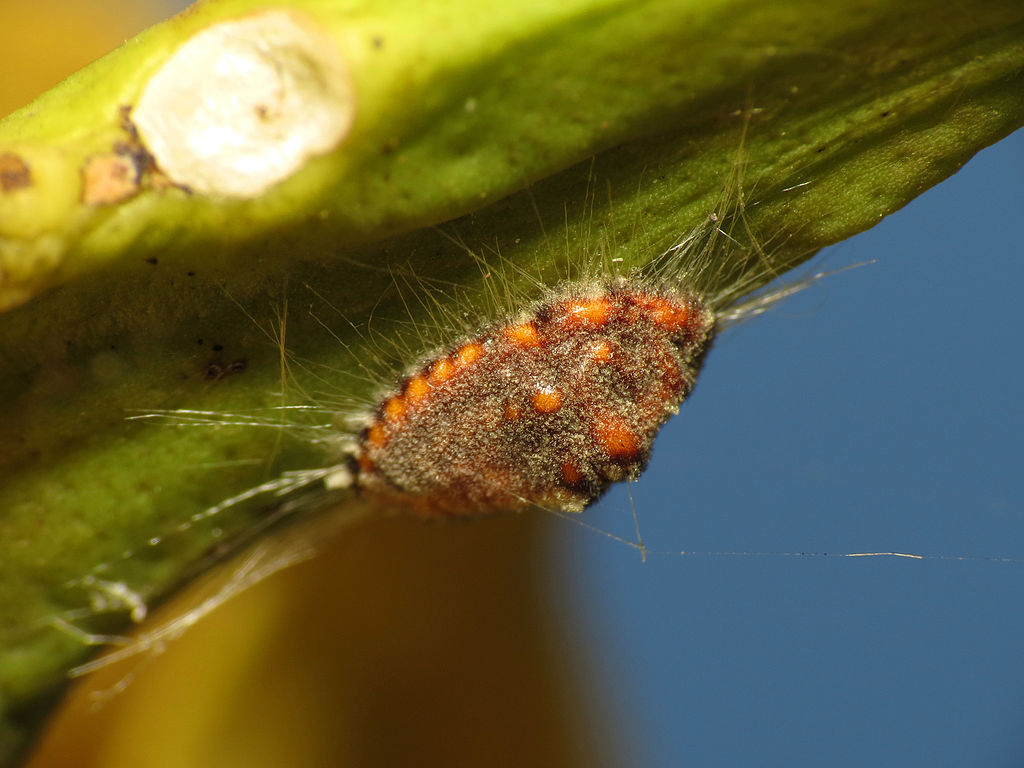
A giant brown soft scale
Related: How To Identify, Control, And Prevent Brown Soft Scale Bugs On Plants?
Armored Scales
Armored scales got their name from hard waxy coverings. They are smaller than soft scales. Therefore, they go unnoticed more than soft scales. They don’t appear as raised bumps like smooth scales and change their body color to the bark of host trees.

A group of armored scales with large-scale coverings
Like soft scale insects, armored scales are also found on the underside of leaves and stems. The mode of injury is also similar to soft scale insects.
The armored scales inject toxins to host leaf tissues during feeding on host plants. These toxins disrupt the nutrient flow and cause cell death (developing yellow or brown halo on damaged leaves). In severe infestations, the armored scales cause premature falling and the death of leaves.
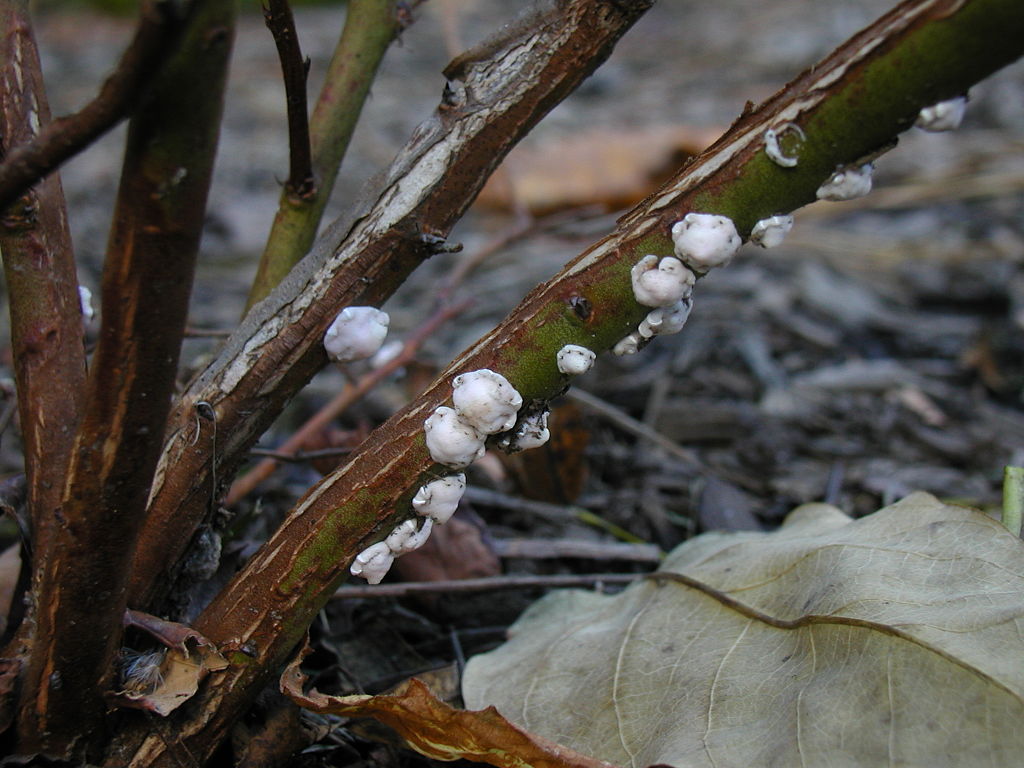
Oyster shell scale insects on host plant
Most importantly, armored scales do not produce any kind of honeydew, so black ants and sooty mold fungus are not a problem for these pests.
Furthermore, they have a limited host range and do not harm indoor plants like soft scales.
How Do You Get Rid Of Scale Insects?
Most scale insects, particularly adult scales, are challenging to control with chemical insecticides. Because they produce hard waxy coverings on their bodies that repel contact insecticides, we need systemic insecticides for scale control.
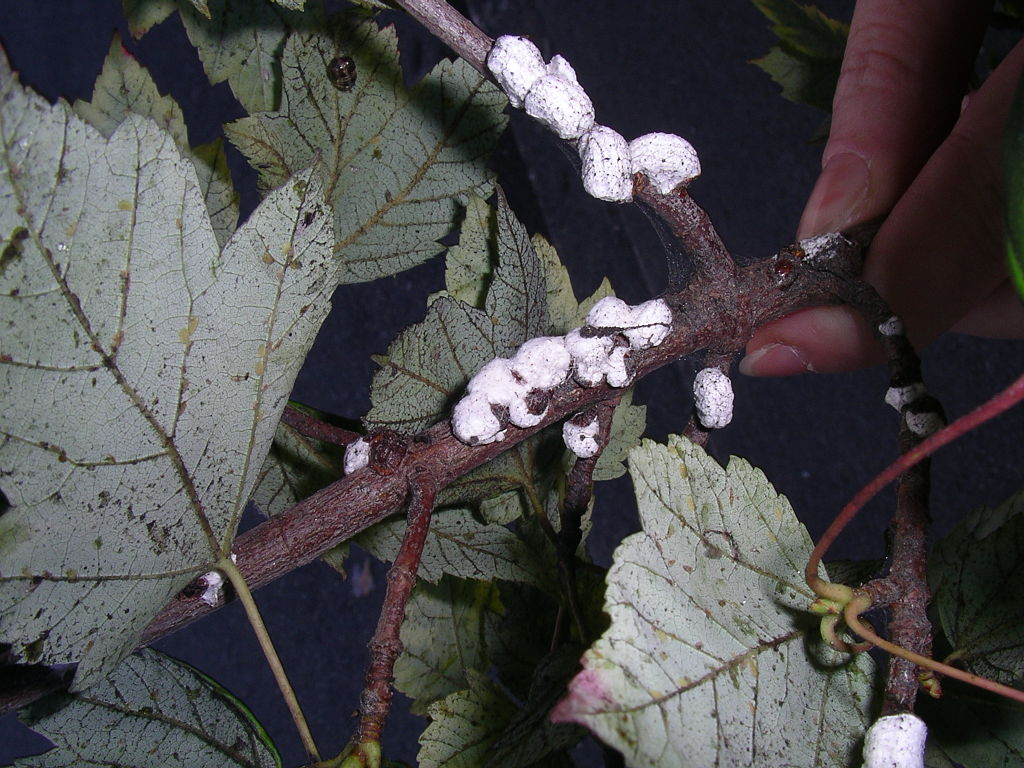
Cottony maple scale
The only best approach to control scale species is at newly hatched nymphs because they lack hard shell-like coverings.
The effective strategy to control scale populations are integrated pest management. These are
- Cultural control
- Biological control
- Chemical control
Cultural Control
- To prevent the further spread of scale species, prune and dispose of the infested leaves, branches, and stems.
- When the scale populations are low, try to remove them manually and monitor the plants for new infestations.
- The soft scales are a problem for indoor plants, but the adult armored scales do not infect them. Therefore, apply high stream water to wash them off forcibly.
- Hang yellow sticky traps in the garden and near houseplants to attract the male scale insects and interfere with mating. In this way, the scale insects will not have a next-generation cycle. However, some scale species reproduce without mating.
- Discard the heavily infested plants because there is no way you can revive them. The scale insects suck out the plant juices and impact their strength.
Biological Control Agents
Biological control involves the introduction of natural enemies of scale insects.
Encourage Beneficial Insects For Scale Control
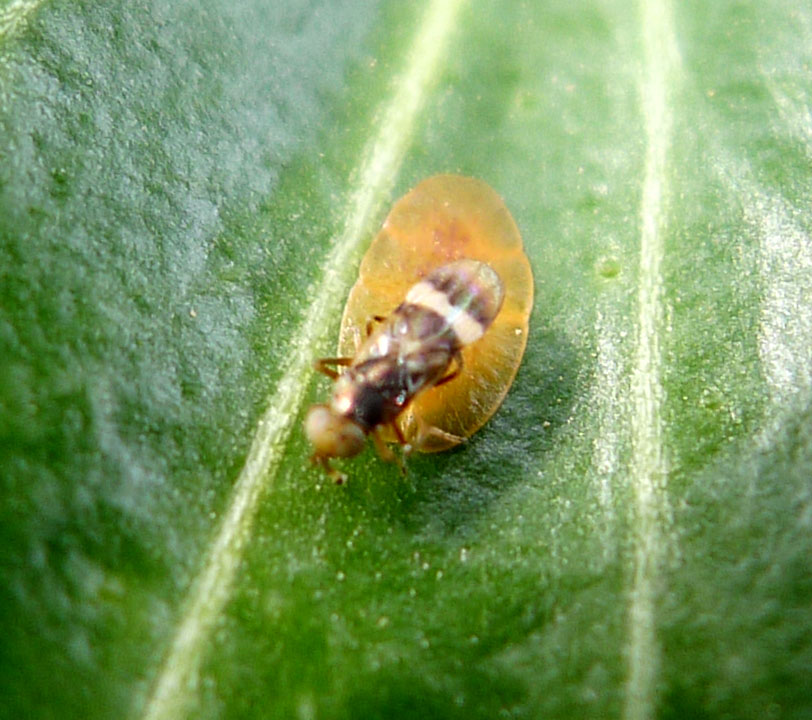
A female parasitic wasp is laying eggs on a brown scale
Scale insects have a more comprehensive range of natural predators vital in their population reductions, such as parasitic wasps, ladybugs, and green lacewings. For example, the female parasitic wasps deposit their eggs underneath the waxy coverings of both soft and armored scales.
Upon hatching these eggs, the wasps’ larvae aggressively feed on the insect body beneath the waxy body covering. As a result, these natural predators keep the scale numbers low and protect plants.
At the same time, the lady beetles eat more aggressively than the crawlers of scale insects. Thus, destroying them before reaching the adult stage.
Chemical Control
This approach involves using various products that contain high to least toxic chemicals as active ingredients.
Apply Azamax
Azamax contains azadirachtin (anti insecticidal properties) as an active ingredient. The concentrated applications of azamax prove organic protection against scale insects. In addition, it offers multiple routes for the management of scales.
- Stop scale insect growth and development
- Interfere with insect feeding
Use Horticultural Oils & Oil-based Insecticides
Horticultural oils, and other oil-based insecticides play a crucial role in managing scale insects. These oils suffocate the scales at all life cycle stages and keep their numbers low. Even the application of these oils provides adequate protection against armored scales.
Apply Insecticidal Soap
Insecticidal soap offers an organic solution for managing most species scales. In addition, the biweekly applications of insecticidal soap and vegetable oil provide long-term protection against soft scale.
Frequently Asked Questions
Soft Scales Vs. Armored Scales?
| Soft Scale | Armored Scale |
| Produce copious amounts of honeydew | Do not produce honeydew on infested plants |
| ⅛ to ¼ inches long | 1/16 to ⅛ inches long |
| Crawlers are of pale color, and mobile | Crawlers inject toxins to host plant and cause injury |
| In adults, the soft waxy covering adheres to the body tightly | In adults, the complex waxy covering do not adhere to the body |
| Examples are brown soft scale, European elm scale, Magnolia scale, and Hemispherical scale | Examples are pine needle scale, oyster shell scale, San Jose scale, and Euonymus scale |
Do Scale Insects Live in the Soil?
Yes, scale insects do live in soil but only for protection from natural predators or in the soil of houseplants. In outdoor gardens and plants, they remain attached to leaves, branches, and stems. They can hide in tree barks and branches. So, the scale insects are the pest that lives on trees and shrubs.
Do Birds Eat Scale Insects?
The 57 species of birds eat scale control actively and help gardeners. It includes songbirds, bluebirds, sparrows, warblers, oriole, jay, and woodpeckers. These birds feed on a diverse menu ranging from mealybugs to whiteflies, aphids, grasshoppers, Japanese beetles, caterpillars, and scale insects.
These insects add more excellent proteins to the bird’s diet.
At the same time, the birds keep their numbers at a lower level (almost 50 insects per day).
Do Ants Spread Scale?
Yes, ants spread scale and take care of them. They move them to new uninfected hosts to get more honeydew. If there were more scale populations, then there would be more honeydew. Therefore, the ants protect the scale insects throughout their life cycle and fight with their natural predators. As a result, the ants get a fixed amount of sticky, sugary food material.
What Plants Do Scale Insects Affect?
Scale insects are the most severe pest of ornamental plants, trees, and shrubs. They cause severe damage to host plants, such as
- Reduced plant vigor
- Draw out plant nutrients through piercing-sucking mouthparts that turn foliage into brown and yellow
- Wilting of plants
- Withering
- Leaf distortion and browning of tips
- Produce honeydew that supports the growth of black ants and sooty mold fungus
To control these nasty and resilient pests, spray indoor plants with horticultural oil, neem oil (Azamax), insecticidal soap, and systemic insecticides.
In outdoor spaces, encourage birds by providing them homes and food sources. Also, establish beneficial insects such as lady beetles, lacewings, and parasitic wasps. These natural enemies provide the Gardners protection by feasting on scales.
Do Scale Insects Fly?
Scale insects do not fly except the males (resembling flying gnat flies). The female scale is legless and remains sessile throughout their life. The young crawlers (first stage) have legs and antennae and crawl over a smaller distance.
Once they find suitable feeding sites for themselves, they remain attached to them and undergo several molts before emerging as adults.
Are Mealybugs and Scale the Same?
Both mealybugs and scale insects are members of the same order Homoptera like aphids, but they are not the same pest. Mealybugs are a type of scale that invade and infect plants.
Sources For Further Reading
- Alabama Cooperative Extension System. (2019, October 15). Controlling Scale Insects and Mealybugs. Retrieved May 6, 2022, from https://www.aces.edu/blog/topics/lawn-garden/controlling-scale-insects-and-mealybugs/
- Kabashima, J. N. (2014, September). Scale Management Guidelines–UC IPM. University of California Statewide IPM Program. Retrieved May 6, 2022, from http://ipm.ucanr.edu/PMG/PESTNOTES/pn7408.html
- Scale Insects | Horticulture and Home Pest News. (n.d.). Iowa State University Horticulture and Home Pest News. Retrieved May 6, 2022, from https://hortnews.extension.iastate.edu/scale-insects
- Mahr, S. (n.d.-b). Scale Insects. Wisconsin Horticulture. Retrieved May 6, 2022, from https://hort.extension.wisc.edu/articles/scale-insects/
Hope this article will help you deal with scale insects. Make sure to check out our other articles:
How to Prevent Gnats in Houseplants? Plus Effective Tips!
How to Kill Mealybugs on Plants With Organic and Inorganic Methods?
What Are the Best Practices to Get Rid of Destructive Leaf Miners?







